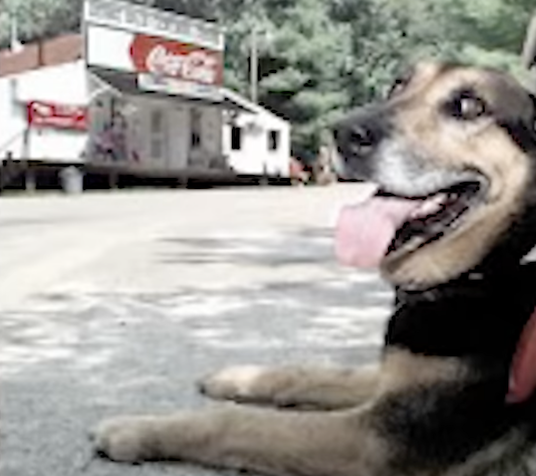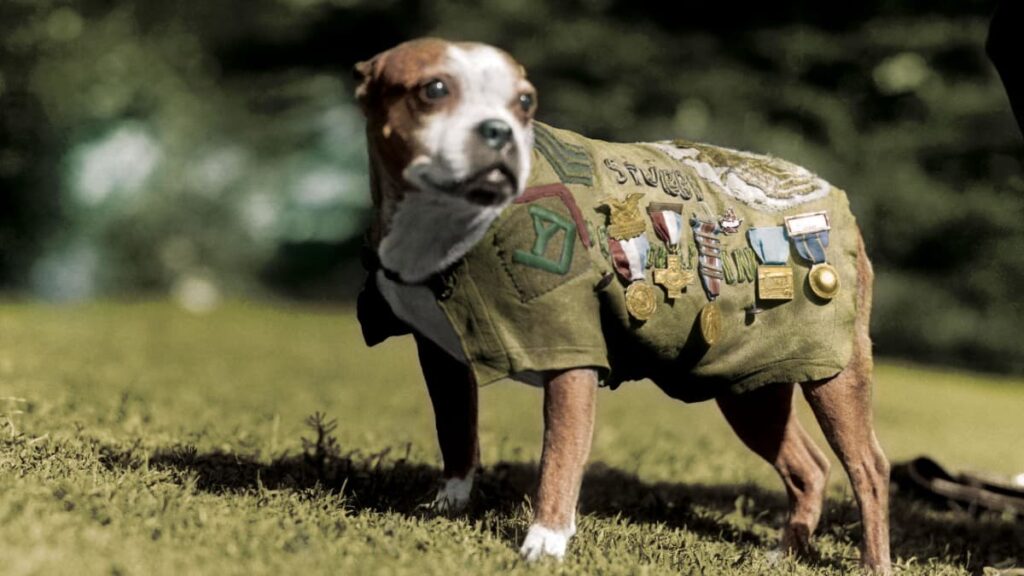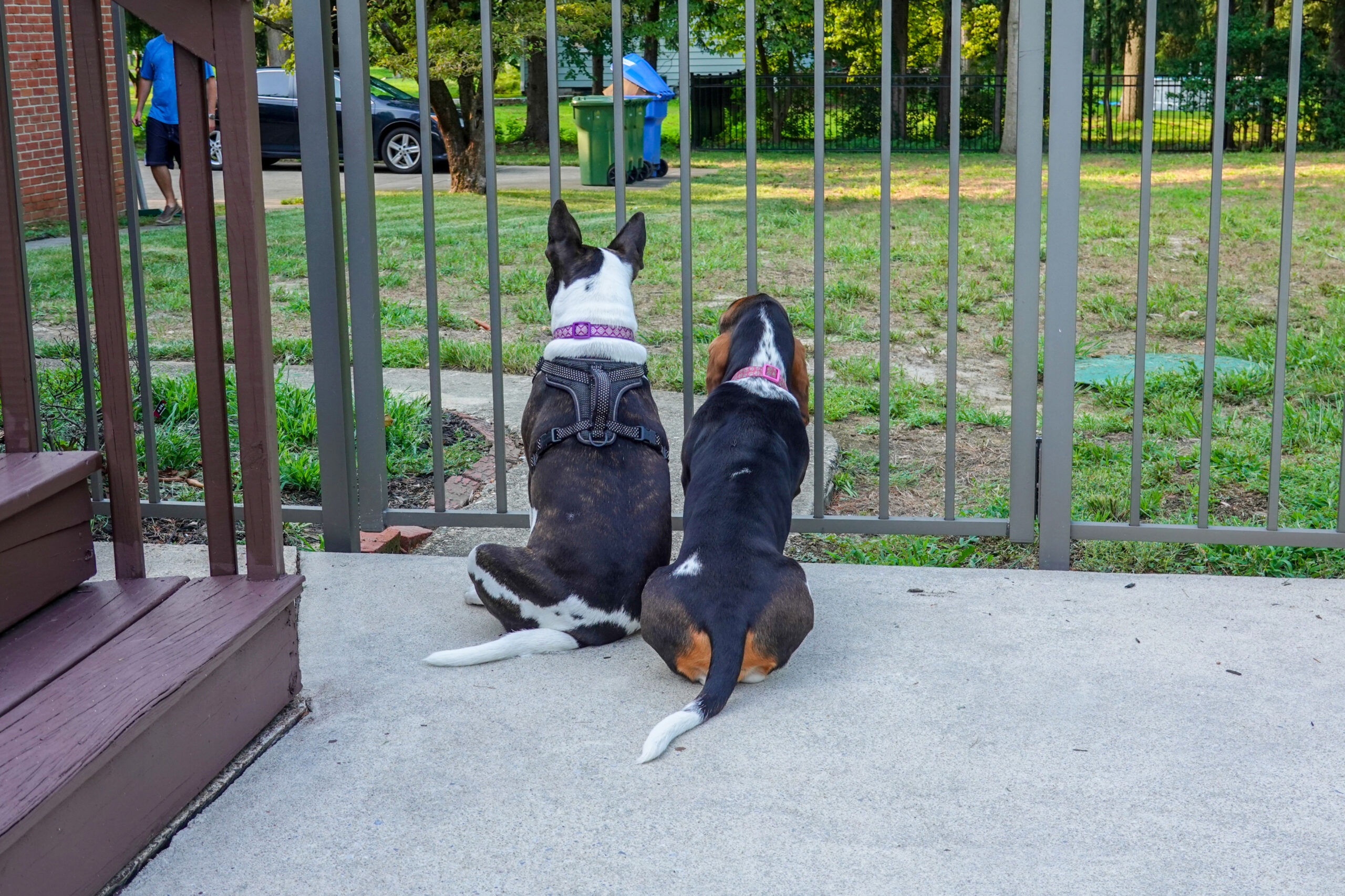1. Dogs Have Unique Fingerprints on Their Nose

You’ve probably heard that human fingerprints are unique, but did you know every dog has a one-of-a-kind nose print? Just like a fingerprint, a dog’s nose has ridges, patterns, and textures that are completely unique to them—no two dogs have the same nose print, even if they’re identical twins. This discovery has led some companies to explore nose-print identification as a way to track lost dogs. Instead of relying on microchips or collars, some shelters and security firms are experimenting with scanning nose prints as a more natural way to identify dogs.
This isn’t just a fun fact—it’s been used in real-life crime investigations. In Canada, a company called NOSEiD created a database where pet owners can register their dog’s nose print as proof of identity. And in one famous case, police reportedly used a dog’s nose print left at a crime scene to link a suspect to a burglary. So, next time your dog presses their wet nose against your hand, remember—you’re basically getting a one-of-a-kind signature. It’s nature’s way of giving them an identity more secure than a fingerprint.
2. Puppies Are Born Completely Deaf

When puppies are born, they are completely deaf—their ear canals are sealed shut, preventing them from hearing anything for the first 10 to 14 days of life. This is because dogs, like many mammals, are born in an underdeveloped state, relying on touch, smell, and warmth to survive before their senses fully kick in. But once their ears open, something incredible happens—their hearing rapidly becomes far superior to ours, allowing them to detect sounds up to four times farther away than humans.
By the time a puppy is just a few weeks old, they can hear high-pitched frequencies up to 65,000 Hz—far beyond the human range of 20,000 Hz. This means they can pick up on rodents scurrying, ultrasonic sounds from electronics, and even distant thunder long before we do. Their ability to pinpoint sound sources is so precise that some police and military dogs can locate a target purely by listening. So, while a newborn puppy starts out in complete silence, within a matter of weeks, they gain one of the sharpest hearing abilities in the animal kingdom.
3. Dogs See the World in Slow Motion

Dogs are expert motion detectors, able to track fast-moving objects better than humans thanks to their superior flicker fusion rate—the speed at which their eyes process images. While humans process about 60 frames per second, dogs can process around 75–80 frames per second, meaning they see motion in greater detail than we do. This is why dogs excel at chasing balls, tracking prey, or detecting movement in the distance long before we notice it.
Even more fascinating, because of this faster frame rate, dogs experience the world in slow motion compared to us. This ability is crucial for survival—it helps them react to threats faster, track fast-moving objects like birds or squirrels, and anticipate movement more precisely. This is also why dogs may seem uninterested in TV screens with a lower refresh rate—to them, older TVs flicker too much, making the image appear choppy or distorted. However, newer high-definition TVs with higher frame rates are often clearer to dogs, which is why some now enjoy watching dog-specific programming.
4. A German Shepherd Once Became a Multi-Millionaire

Imagine inheriting millions of dollars just for being a good boy. That’s exactly what happened to Gunther III, a German Shepherd who became one of the richest dogs in history after his owner, German countess Karlotta Liebenstein, left him a $80 million fortune when she passed away in 1992. But here’s where it gets even wilder—by the time the money was passed down to his descendant, Gunther IV, the fortune had grown to $400 million thanks to some shockingly smart investments.
Gunther III didn’t just sit on his wealth—his team of human handlers used his fortune to buy luxury mansions, private chefs, and even a Miami villa that once belonged to Madonna. Yes, an actual dog owned Madonna’s house. Gunther IV also had a custom jewel-encrusted collar and reportedly ate steak and caviar for dinner. But the story gets even weirder—recent investigations suggest the whole thing might have been an elaborate hoax, possibly used for tax breaks or real estate schemes. Either way, Gunther IV still made headlines around the world, and his supposed fortune remains one of the strangest stories of a dog living better than most humans.
5. Puppies Are Born Completely Deaf

When puppies are born, they are completely deaf—their ear canals are sealed shut, preventing them from hearing anything for the first 10 to 14 days of life. This is because dogs, like many mammals, are born in an underdeveloped state, relying on touch, smell, and warmth to survive before their senses fully kick in. But once their ears open, something incredible happens—their hearing rapidly becomes far superior to ours, allowing them to detect sounds up to four times farther away than humans.
By the time a puppy is just a few weeks old, they can hear high-pitched frequencies up to 65,000 Hz—far beyond the human range of 20,000 Hz. This means they can pick up on rodents scurrying, ultrasonic sounds from electronics, and even distant thunder long before we do. Their ability to pinpoint sound sources is so precise that some police and military dogs can locate a target purely by listening. So, while a newborn puppy starts out in complete silence, within a matter of weeks, they gain one of the sharpest hearing abilities in the animal kingdom.
6. Dogs Can Hear Sounds That Would Be Completely Silent to Us

We all know dogs have great hearing, but their ears are so powerful that they can pick up sounds at frequencies humans will never be able to hear. While we can detect sounds up to 20,000 Hz, dogs can hear up to 65,000 Hz, meaning they can catch the high-pitched squeaks of tiny rodents, the ultrasonic hum of electronics, and even the vibrations of termites chewing inside walls. This is why dogs sometimes bark at things you can’t see or hear—they’re picking up on sounds way beyond our range.
But it gets even more mind-blowing. Dogs not only hear better than us, but they can pinpoint exactly where a sound is coming from in just 0.06 seconds—faster than most high-tech audio equipment. Their ear muscles are like mini satellite dishes, able to rotate independently to focus on different noises. This ability makes them incredible at detecting intruders, sensing danger, and even hearing their guardian’s footsteps from blocks away. Some police and military dogs are trained to listen for specific sounds—like the clicking of a gun being cocked—so they can react before anyone else even realizes what’s happening. In short, your dog isn’t just hearing better than you—they’re hearing an entirely different world.
7. Dogs Are Genetically 98.8% Wolf But Some Breeds Are Even Closer

Even though they look different, modern dogs and gray wolves share 98.8% of their DNA, proving that all domestic dogs—from tiny Chihuahuas to massive Great Danes—descended from wolves thousands of years ago. However, some breeds are genetically closer to wolves than others. Studies have found that breeds like the Shiba Inu, Akita, Alaskan Malamute, and Siberian Husky retain more wolf-like traits in their DNA compared to other dogs. These breeds often have strong prey drives, independent personalities, and thick double coats similar to their wild ancestors.
One of the biggest differences between modern dogs and wolves is their behavior and digestion. Unlike wolves, dogs have evolved to digest starches and grains, which is why they can eat kibble while wolves rely on pure meat. However, some ancient breeds still retain wolf-like hunting and tracking abilities, making them exceptional in search-and-rescue, sledding, and even guarding livestock. Scientists believe that when early humans tamed wolves thousands of years ago, they selectively bred the ones that were friendlier and more adaptable, which led to the domesticated dogs we know today.
8. A Few Dogs Survived the Titanic

When the Titanic went down in 1912, over 1,500 people perished—but did you know that three dogs actually survived? Among them was a tiny Pomeranian named Lady, who belonged to first-class passenger Margaret Hays. As the ship began to sink, chaos broke out, but Margaret managed to wrap Lady in a blanket and carry her aboard Lifeboat 7, passing her off as a baby. Given the circumstances, no one questioned it. When they were rescued by the Carpathia, Lady remained nestled in Margaret’s arms, one of the only non-human survivors of the disaster.
But Lady wasn’t the only lucky pup. Another Pomeranian and a Pekingese named Sun Yat-sen also survived, thanks to their wealthy owners who smuggled them onto lifeboats. The rest of the Titanic’s dogs—mostly larger breeds housed in the ship’s kennels—weren’t as fortunate. Before the ship went down, crew members reportedly released the dogs, and some passengers recalled seeing them swimming in the freezing waters. The saddest part? One passenger, millionaire Harry Anderson, refused to leave without his beloved Great Dane and chose to stay behind rather than board a lifeboat without her. To this day, artifacts from the Titanic occasionally surface—including the collar of a lost dog, which was recovered from the wreckage and auctioned off for nearly $12,000.
9. Dogs Can Tell the Difference Between Happy and Angry Faces

Dogs don’t just recognize human expressions—they understand emotions by reading faces, just like we do. Scientists tested this by showing dogs pictures of people with different expressions—happy, angry, neutral—and the results were stunning. Dogs consistently reacted differently to smiling faces versus angry ones, often approaching happy people and avoiding those with furrowed brows or aggressive expressions. What’s even more impressive? They don’t just react in the moment—they remember who treats them well and who doesn’t.
In one study, dogs watched two groups of people: one group helped their guardian open a difficult container, while the other refused to help. Later, when given a choice of who to approach for food, the dogs consistently avoided the unhelpful people, showing they could judge human behavior and hold grudges. Another experiment found that dogs could even recognize facial expressions on TV, reacting differently to videos of smiling and frowning people. This means your dog isn’t just reading your mood—they’re actively evaluating people around them, deciding who’s trustworthy, and remembering it long after the moment has passed.
10. A Dog Became a Mayor and Was Re-Elected

Most politicians have a bark worse than their bite, but one small town in Kentucky decided an actual dog was a better choice for mayor. Meet Goofy Borneman, a dog who won the mayoral election in Rabbit Hash, Kentucky—not once, but multiple times. This wasn’t some joke election either; Rabbit Hash is famous for electing dogs as honorary mayors, and Goofy’s political career started in the 1990s when locals realized they liked his company more than most human candidates. But Goofy wasn’t the only canine politician—he was just one in a long line of dog mayors. Other four-legged leaders of Rabbit Hash have included a Border Collie named Lucy Lou, a rescue pit bull named Brynneth Pawltro, and a friendly Golden Retriever named Wilbur.
Goofy’s reign as mayor wasn’t just for laughs. His position helped raise money for local historical preservation efforts, and his popularity turned Rabbit Hash into a quirky tourist attraction. But he’s not alone in the world of dog politics—other towns have also had dog mayors, including Idyllwild, California, where a Golden Retriever named Max was elected as a lifetime mayor and even had his own custom uniform. These honorary titles show just how much people trust and adore dogs, sometimes more than their human counterparts. After all, dogs don’t pass bad policies—they just wag their tails, pose for photos, and make everyone feel like they’re the most important person in the room.
11. Dogs Can Smell Time

Your dog isn’t psychic, but it sure seems like it when they’re sitting at the door, tail wagging, right as you pull into the driveway. But here’s the wild part—they’re not just guessing when you’ll be home. Dogs can actually smell time. Unlike humans, who rely on clocks, routines, and muscle memory to track time, dogs use their noses. Scientists believe that the longer you’ve been gone, the more the scent you left behind in the house dissipates. Your dog learns that when your scent reaches a certain faintness, that means it’s about time for you to walk through the door. It’s like a biological clock—only it works through their super-powered sniffer.
But it doesn’t stop there. Some researchers believe dogs can actually detect the movement of time itself through shifting air currents and scent patterns. Think about how a room smells differently in the morning than it does at night—dogs pick up on those micro-level changes. This means they not only know when you’re coming home, but they can also predict things like dinnertime, your usual bedtime, or even when their favorite mail carrier is about to drop off a package. Essentially, dogs have a built-in time-sensing mechanism that makes your wristwatch look primitive. So next time your dog is waiting at the door like they’ve read your mind, just know—they haven’t. They’ve smelled it.
12. A Dog Saved an Entire Town from an Epidemic

In 1925, a deadly diphtheria outbreak was sweeping through the remote town of Nome, Alaska, threatening the lives of hundreds—especially children. The only thing that could save them? A desperately needed supply of antitoxin serum, sitting over 600 miles away in Anchorage. The brutal winter made it impossible for planes to fly, and the only way to get the medicine to Nome was by dog sled. Enter Balto, a Siberian Husky who would go down in history as one of the greatest canine heroes of all time.
Balto wasn’t just any sled dog—he was the lead dog of the final team that delivered the serum in what became known as the 1925 Serum Run, or the “Great Race of Mercy.” Over five and a half days, mushers and their sled dog teams braved temperatures of -50°F, whiteout blizzards, and life-threatening winds to transport the serum across Alaska. Balto and his musher, Gunnar Kaasen, ran the final leg of the journey, covering 53 miles through near-impossible conditions. When they finally arrived in Nome on February 2, 1925, they became instant heroes, saving the town from a devastating epidemic. Today, Balto’s legacy lives on—his taxidermied body is displayed at the Cleveland Museum of Natural History, and a statue of him stands in Central Park, with an inscription that reads: “Dedicated to the indomitable spirit of the sled dogs that relayed antitoxin six hundred miles over rough ice, across treacherous waters, through Arctic blizzards, from Nenana to the relief of stricken Nome in the winter of 1925.”
13. Dogs Have an Internal Compass and Align with the Earth’s Magnetic Field

Ever noticed how your dog circles before they poop? Turns out, they’re not just being picky about the perfect spot—they’re actually aligning with the Earth’s magnetic field. That’s right, your dog has a built-in compass, and they prefer to do their business while facing north or south. This was proven in a study where researchers observed 70 dogs from 37 different breeds over two years and recorded thousands of bathroom breaks (imagine that job). The results? When the Earth’s magnetic field was stable, dogs overwhelmingly positioned themselves along the north-south axis.
But it gets even crazier. Scientists believe this internal compass might be why dogs have an uncanny ability to find their way home—even over long distances. Some lost dogs have traveled hundreds of miles to reunite with their families, and researchers now think it’s not just scent guiding them, but also their ability to detect the planet’s magnetic field. In one study, dogs were observed taking a unique “scouting” behavior before returning to their starting point, suggesting they were recalibrating their internal GPS. It’s almost like they have a secret sixth sense, something we can’t even begin to imagine. So next time your dog is spinning in circles, just know—it’s not random. They’re syncing up with the Earth itself.
14. Dogs Were the First Animals in Space

Before humans ever set foot in space, dogs were paving the way. The most famous of them all? Laika, a stray dog from the streets of Moscow who became the first living being to orbit Earth. In 1957, during the height of the Space Race, the Soviet Union launched Sputnik 2, and inside was Laika, strapped into a tiny capsule with just enough room to stand, sit, and lie down. The Soviets wanted to see if a living creature could survive in space before sending a human, and Laika was chosen because she had already survived the harsh conditions of the streets—scientists believed this made her resilient enough for the mission.
But here’s the heartbreaking part—Laika’s trip was one-way. At the time, there was no technology to bring her back. For decades, Soviet officials claimed she survived for several days, but later it was revealed she died just hours after launch due to extreme heat and stress. Despite this, Laika became a global icon, symbolizing both the triumphs and ethical dilemmas of space exploration. In 2008, Russia finally honored her with a monument in Moscow, depicting her standing atop a rocket. And if you’ve ever wondered why people name their dogs “Laika,” now you know—it’s a tribute to the stray who became a legend.
15. The U.S. Army Had a Canine War Hero Who Was a Sergeant

During World War I, a stray Boston Terrier–Pit Bull mix named Sergeant Stubby went from being a homeless pup to one of the most decorated dogs in military history. He started his journey when he wandered onto the training grounds of the 102nd Infantry Regiment in 1917, where a young soldier named Private J. Robert Conroy took him in. Stubby was smuggled aboard a troop ship to France, where he quickly became more than just a mascot—he was an actual wartime hero.
Stubby saved his unit multiple times, warning them of incoming mustard gas attacks, locating wounded soldiers on the battlefield, and even capturing a German spy—yes, an actual spy. One night, he heard a soldier sneaking through the trenches and attacked him, holding him down until U.S. troops arrived. For his bravery, Stubby was promoted to the rank of Sergeant, making him the first dog to receive an official military title. By the time the war ended, he had served in 17 battles, received a medal from General John J. Pershing, and was later honored with a full-page obituary in The New York Times. Today, his preserved body is on display at the Smithsonian, where he’s remembered as onel,Office—and Held the Position for 13 Years
16. A Dog’s Nose Is Powerful Enough to Detect Diseases, Storms, and Time

We already know that dogs have incredible noses, but their sense of smell is so advanced that they can literally detect things happening inside the human body. Medical studies have proven that dogs can smell cancer, seizures, and even COVID-19 long before medical tests pick them up. In fact, some hospitals now use specially trained “bio-detection dogs” that can identify diseases just by sniffing a person’s breath, sweat, or urine. But here’s where it gets even crazier—dogs don’t need training to do this. Many pet owners have reported that their dog started obsessively sniffing a certain part of their body, only for doctors to later find a tumor or illness in that exact spot.
And it’s not just health—dogs can predict storms, earthquakes, and even time itself using their noses. Their sense of smell is up to 100,000 times stronger than ours, which means they can detect changes in air pressure, moisture, and even electrical signals before a storm hits. Some dogs have been known to act restless or anxious hours before an earthquake, likely sensing underground shifts before humans even register a tremor. And as we talked about earlier, they can also “smell time” by tracking how scents fade throughout the day. Essentially, a dog’s nose is like a superpower, allowing them to sense the world in ways we can’t even imagine.
17. Dogs Can Recognize Themselves But Not in Mirrors

Most animals, including dogs, fail the classic “mirror test”—a psychological experiment where a mark is placed on an animal’s body to see if they recognize their reflection as themselves. Unlike humans, apes, dolphins, and elephants, dogs don’t seem to recognize their own reflection in a mirror. But that doesn’t mean they don’t have self-awareness—they just use a different method. Instead of relying on sight, dogs recognize themselves through scent, and when researchers created a version of the mirror test using smells instead of visual cues, dogs passed with flying colors.
In one experiment, dogs were presented with their own scent, the scent of another dog, and a version of their own scent that had been slightly altered. The results? Dogs immediately noticed when their own smell had changed, proving that they understand their personal identity through smell rather than sight. This means that when your dog sniffs another dog, a fire hydrant, or even their own tail, they’re gathering far more information than we ever could by looking in a mirror. To put it in perspective, imagine if you could instantly recognize your past meals, mood, and health just by sniffing the air—you’d never need a mirror again!
18. Dogs Can Cry Real Tears

You know how your dog seems to know exactly when you’re sad? It’s not just in your head—studies show that dogs can actually absorb and mirror human emotions to the point where they physically react to our moods. When a person cries, a dog’s stress levels rise, their heart rate changes, and they often approach their guardian with comforting behavior. But here’s where it gets even wilder—dogs don’t just sense emotions, they can actually catch them like a virus. Researchers found that if you’re stressed, anxious, or even yawning, your dog is more likely to feel the same way, mimicking your emotional state.
And it doesn’t stop there. A recent study from Japan revealed that dogs can actually produce tears of joy when reunited with their favorite humans after a long absence. Scientists measured the amount of moisture in dogs’ eyes before and after they saw their guardians, and the results were stunning—dogs produced more tears when experiencing happy emotions, much like humans do. This might explain why your dog greets you so dramatically after you’ve been gone for a while—it’s not just excitement, it’s genuine emotional relief. So the next time your pup stares at you with big, watery eyes, just know—they might actually be crying tears of happiness because they love you that much.
19. Dogs Have Built-In Night Vision

Ever wonder why your dog can navigate the house at night without bumping into anything, while you’re stumbling to find the light switch? That’s because dogs have a built-in night vision system that makes them far superior in the dark. Unlike humans, whose eyes struggle in low light, dogs have a special mirror-like structure in their eyes called the tapetum lucidum. This layer sits behind the retina and reflects light back through the eye, giving them a second chance to process even the smallest amount of available light. That’s why their eyes glow in the dark when hit with a flashlight—it’s the tapetum reflecting the light back.
But their night vision isn’t just about glowing eyes—dogs also have more rod cells in their retinas than humans, which makes them better at detecting motion in low light. This means they can spot a moving object in near total darkness—a crucial survival skill for their wolf ancestors who hunted at dawn and dusk. So while your dog may not see colors as vividly as you do (they see the world in muted blues and yellows), when the sun goes down, they’ve got a serious advantage over humans. That’s why they’ll notice a squirrel in the shadows before you do—and why they always seem eerily confident walking around in the pitch black.
20. Dogs Have Been Helping Humans for Over 30,000 Years And May Have Saved Us From Extinction

Dogs weren’t just the first domesticated animals—they may have actually helped humans survive when other species didn’t. Archaeological evidence shows that dogs and humans have lived together for at least 30,000 years, dating back to Ice Age hunter-gatherers. Early humans and wolves formed a mutual survival pact, with wolves helping humans hunt while humans shared food. Over time, the most social and cooperative wolves evolved into the first dogs, kickstarting a relationship that changed both species forever. But here’s the shocking part—some scientists believe dogs gave humans an evolutionary advantage over Neanderthals, who disappeared around 40,000 years ago.
Unlike Neanderthals, who had no domesticated animals, early Homo sapiens had dogs helping them track and hunt prey, giving them better access to food. Studies suggest this could have played a key role in why modern humans thrived while Neanderthals went extinct. In fact, dogs were so valuable that some were buried alongside their human companions, with ancient gravesites showing evidence of people and dogs buried together, sometimes even with ceremonial objects. This means that not only have dogs been with us for thousands of years—they may have literally helped shape human history.
21. A Dog’s Heart Beats Faster Than Yours

Dogs may seem relaxed most of the time, but their hearts are working overtime compared to ours. The average human heart beats around 60-100 times per minute, while a dog’s heart beats between 70-160 times per minute, depending on size—the smaller the dog, the faster the heart rate. A Chihuahua’s heart can race at 150 beats per minute, while a Great Dane’s might be closer to 80 BPM. This high metabolism helps fuel their constant energy, quick reflexes, and ability to recover from injuries faster than humans.
But here’s where it gets even crazier—studies have shown that a dog’s heartbeat actually synchronizes with their guardian’s when they’re close together. In one experiment, researchers monitored both a human’s and a dog’s heart rate as they spent time together. The results? Their pulses began to mirror each other, proving that the bond between dogs and humans isn’t just emotional—it’s physiological. Even more amazing, when a dog sees their favorite human after time apart, their heart rate spikes with excitement, much like when a person sees someone they love. So next time your dog greets you like it’s the greatest moment of their life, just know—it’s not just enthusiasm, their heart is literally racing with joy.
22. Dogs Can Survive Falls From Extreme Heights

It sounds impossible, but dogs have been known to survive falls from multi-story buildings—sometimes with barely a scratch. This is due to what veterinarians call “high-rise syndrome,” a phenomenon where dogs (and cats) instinctively spread their legs, adjust their body position, and slow their descent when falling from a great height. Their flexible spines and strong leg muscles absorb the impact, reducing serious injuries. There have even been cases of dogs falling from over 20 stories and surviving, though smaller falls can sometimes be more dangerous because they don’t have enough time to adjust their posture before hitting the ground.
One of the most famous cases occurred in New York City, where a dog fell from a sixth-floor balcony—and walked away almost unharmed. This survival ability is why many veterinarians actually see fewer severe injuries in dogs that fall from higher floors than those that fall from just one or two stories. The key is their air-righting reflex, which allows them to adjust mid-air, much like a parachute effect. However, this doesn’t mean they’re invincible—broken bones and internal injuries can still happen, but their survival rate is shockingly high. So, while humans wouldn’t stand a chance, dogs have an incredible natural ability to defy gravity.
23. Dogs Can Detect Earthquakes Before They Happen and Scientists Don’t Understand How

For centuries, people have reported dogs acting strangely before earthquakes, sometimes barking, whining, or trying to escape minutes—or even hours—before the ground starts shaking. In 373 BCE, ancient Greek records claimed that dogs fled the city of Helike days before a massive earthquake wiped it out. More recently, in Japan and California, people have observed dogs refusing to enter buildings just before earthquakes struck. But here’s where it gets weird—scientists still aren’t entirely sure how they do it.
One theory is that dogs sense tiny vibrations in the ground long before humans can. Their paws are packed with nerves that may allow them to detect subtle seismic shifts. Another possibility? Dogs might hear ultrasonic sounds created by rocks grinding together deep beneath the earth’s surface—frequencies that are completely silent to us. Some researchers even believe dogs can detect changes in atmospheric pressure or underground gases that leak before a quake. While scientists haven’t cracked the mystery yet, many earthquake-prone countries now encourage people to watch their dogs’ behavior as an early warning sign. So if your dog suddenly starts acting anxious for no reason—especially in an area prone to earthquakes—you might want to pay attention.
24. Dogs Can Smell a Single Drop of Liquid in 20 Olympic-Sized Swimming Pools

Dogs don’t just have a great sense of smell—they have one of the most powerful noses in the entire animal kingdom. While humans have about 5 million scent receptors, dogs have anywhere from 125 to 300 million, depending on the breed. Bloodhounds, known for their tracking abilities, have up to 300 million scent receptors, making them the undisputed champions of smell. But here’s where it gets insane—a dog’s nose is so sensitive that it can detect a single drop of liquid in the equivalent of 20 Olympic-sized swimming pools. That’s how precise their noses are.
This ability isn’t just impressive—it’s life-saving. Dogs are used to detect everything from cancer and diabetes to explosives and missing people. In fact, trained medical detection dogs can sniff out some diseases with 97% accuracy, often before medical tests can confirm them. Some law enforcement agencies even train dogs to detect USB drives and hidden electronics, as tiny traces of chemicals inside these devices give off distinct scents that humans would never notice. So the next time your dog sniffs something intensely, just know—they’re picking up details in the air that we can’t even begin to comprehend.
25. Dogs Can Understand Over 250 Words and Some Are as Smart as a 2-Year-Old Child

Dogs aren’t just great listeners—they actually understand human language at a level that rivals small children. Studies have shown that the average dog can recognize 165 words, while the smartest breeds—like Border Collies, Poodles, and German Shepherds—can learn over 250 words and commands. One of the most famous examples is Chaser, a Border Collie who knew the names of 1,022 different objects and could even differentiate between nouns and verbs. Scientists tested her by asking her to fetch specific toys from a pile of hundreds, and she got it right almost every time.
But it’s not just words—dogs are also capable of basic math and problem-solving. Some dogs have been observed counting treats, choosing the larger pile when given a choice. Others can figure out how to open doors, solve puzzles, and even deceive humans to get what they want. In one experiment, dogs were given the chance to steal food when their guardian wasn’t looking, and they consistently waited for the perfect moment—proving they understood the concept of human attention. So next time you think your dog doesn’t understand what you’re saying, just remember—they probably know more than they let on.
26. Dogs Can Find Their Way Home From Miles Away Without a Scent Trail

Dogs don’t just rely on their noses to navigate—they also seem to have an internal GPS, allowing them to find their way home even from miles away. While scent plays a role, researchers have discovered that dogs may also be using the Earth’s magnetic field to orient themselves, much like migratory birds and sea turtles. In one study, scientists tracked 27 dogs across 600 trials and found that when they were lost, many would first pause, reorient, and align themselves along the Earth’s north-south axis before heading in the right direction. This suggests that dogs may have a hidden “magnetoreception” sense that helps them navigate.
Some real-life cases of lost dogs traveling extreme distances seem to support this. One of the most famous stories is about a Collie mix named Bobbie, who got separated from his family on a trip in 1923. Instead of staying lost, Bobbie traveled 2,551 miles across deserts, rivers, and mountains to return home to Oregon—six months later. He had never made the trip before, and no one knows exactly how he did it. Cases like Bobbie’s continue to baffle scientists, but one thing’s clear: dogs have an uncanny ability to find their way home, even when logic says they shouldn’t be able to.
27. Dogs Can Hear the Whir of a Lightbulb And Detect Electricity

Dogs don’t just hear better than us—they hear sounds that we don’t even realize exist. While humans can detect sounds up to 20,000 Hz, dogs can pick up frequencies as high as 65,000 Hz, meaning they can hear the electrical buzz of wires in walls, the hum of a TV screen, and even the vibration of a lightbulb filament. If your dog ever seems to bark at nothing, chances are they’re actually reacting to sounds you can’t hear.
This super-hearing also makes dogs experts at detecting trouble before it happens. Some service dogs are trained to pick up on the faintest changes in sound, allowing them to alert people before seizures, low blood sugar episodes, or even heart attacks occur. Police and military dogs use this ability to hear distant gunfire, high-frequency electronic signals, or even the faint clicking of a safe being cracked open. Their ears work almost like radar dishes, constantly scanning their environment for any noise that doesn’t belong. So the next time your dog tilts their head or stares at something invisible, they’re not imagining things—they’re hearing a hidden world of sounds we’ll never be able to experience.
28. Dogs Know When You’re Lying

Dogs don’t just read body language—they can actually smell emotions like fear, happiness, and stress. Scientists have found that when a person experiences strong emotions, their body releases chemical changes in sweat and breath, which dogs can detect. In one experiment, researchers collected sweat samples from people watching happy or scary movies, then presented the samples to dogs. The results? When smelling the sweat of a scared person, dogs became more anxious, showing that they were physically reacting to human emotions—just from scent alone.
Even more impressive, dogs can tell when a human is being deceptive. Studies show that if a person lies or gives misleading cues, dogs pick up on subtle changes in scent, tone, and behavior. In one experiment, researchers tested dogs by having two people point at food containers—one person was truthful, the other intentionally misleading. Over time, dogs stopped trusting the liar and ignored their instructions, proving they can recognize dishonesty. This ability makes them invaluable as search-and-rescue animals, service dogs, and even courtroom support dogs, where they comfort victims by sensing emotional distress. So if your dog ever seems suspicious of someone, you might want to trust their instincts—they can smell something you can’t.
29. Not All Dogs Are Colorblind

You’ve probably heard that dogs only see in black and white, but that’s a myth. While dogs don’t see the full spectrum of colors like humans do, they aren’t completely colorblind—they actually see the world in shades of blue and yellow. Unlike humans, who have three types of color receptors (cones) in their eyes, dogs only have two, meaning they can’t see reds and greens the way we do. To them, red appears as a dark brownish-gray, while green looks like a dull yellow.
But here’s the wild part—dogs may actually be able to see ultraviolet (UV) light, allowing them to detect things that are completely invisible to humans. Scientists have found that certain animals, including dogs, have UV-sensitive structures in their eyes, which means they might be able to see patterns on flowers, traces of urine, or even glowing trails left behind by other animals. This could explain why your dog sometimes stares at something that isn’t there—they might be seeing something you physically can’t. So while they don’t see the world the way we do, their vision is still packed with surprises.
30. Dogs Don’t Kick After Pooping to Cover It Up

Ever noticed how dogs kick the ground after they go to the bathroom? It’s easy to assume they’re trying to cover up their mess, like a cat in a litter box—but that’s not what’s happening. The real reason dogs kick after pooping is to spread their scent and mark their territory. This behavior, called ground scratching, is an instinct hardwired into their DNA. When a dog kicks, they activate scent glands in their paws, which release pheromones that leave behind a chemical message for other animals.
This behavior is especially common in wolves, coyotes, and wild dogs, where scent marking is crucial for survival. The scratches on the ground also serve as a visual marker, reinforcing their claim on an area. Researchers have found that dominant dogs are more likely to kick aggressively, while more submissive dogs may avoid it altogether. Some studies even suggest that ground scratching can act as a form of communication, signaling to other dogs whether an area is safe or already “claimed.” So next time your dog kicks up a storm after doing their business, just know—they’re not cleaning up after themselves. They’re leaving an invisible message for the next visitor.
31. The U.S. Has More Pet Dogs Than People in Some Places

Dogs aren’t just man’s best friend—they’re everywhere. The United States has the largest pet dog population in the world, with an estimated 90 million pet dogs—that’s nearly one dog for every three people. In comparison, Brazil comes in second with around 52 million pet dogs, while China has about 27 million. But some places take their love for dogs to the next level—in certain towns, there are actually more dogs than people.
For example, the town of Carmel-by-the-Sea, California, has a dog-to-human ratio that’s nearly 1:1, with local businesses catering specifically to canine residents. In La Rinconada, Peru, one of the highest-altitude settlements in the world, stray dogs actually outnumber humans due to the town’s mining boom. Even entire countries have shockingly high dog populations—France has more than 17 million pet dogs, making it one of the most dog-loving places on Earth. With numbers like these, it’s no surprise that the pet industry is worth over $100 billion globally, with Americans alone spending $50 billion a year on their furry friends.
32. Dogs Have a Cooling System Built Into Their Paws

Dogs don’t sweat the way we do—they don’t have sweat glands all over their bodies. Instead, they regulate their temperature through panting and sweating only through their paw pads. Unlike humans, who cool off by sweating through millions of glands, dogs rely on their tongue, respiratory system, and footpads to release heat. This is why after running around, dogs pant heavily—they’re rapidly exchanging hot air for cooler air, which helps them cool down much faster than sweating would.
But here’s a little-known fact—dogs do have a very small number of sweat glands in their paws, which is why you might notice wet paw prints on the floor during hot weather. These glands don’t do much for cooling, but they help dogs grip surfaces and even release scent when they scratch the ground. This is why you’ll sometimes see a nervous or hot dog leaving damp paw prints behind. It’s one of their body’s few built-in cooling mechanisms, and it’s part of why dogs are much more sensitive to extreme heat than humans. If they overheat, they can suffer from heatstroke much faster than we can, making shade and hydration essential for their survival.
33. Dogs Wagging Their Tails is Not Always a Sign of Happiness

Most people assume a wagging tail means a dog is happy, but that’s not always true. Dogs actually use tail wagging as a form of communication, and the direction, speed, and height of the wag all mean different things. Studies have shown that when a dog wags their tail to the right, it usually means excitement, happiness, or a friendly greeting. However, if they wag to the left, it can indicate nervousness, caution, or even aggression. This is because the left side of a dog’s brain controls positive emotions, while the right side processes fear and anxiety—and their body movements reflect these emotions.
Tail height also matters. A high, stiff wag can be a warning sign, especially in confident breeds like Malinois or Dobermans, while a low, loose wag is more likely a sign of relaxation. Even no wagging at all can be a clue—if a dog holds their tail completely still and stiff, they might be feeling threatened or uncertain. Scientists believe that dogs evolved these subtle tail signals to communicate with each other and with humans, making tail wagging one of the most complex and misunderstood behaviors in the animal kingdom. So, next time you see a wagging tail, pay attention—it might not mean what you think it does.
34. Greyhounds Can Outrun a Cheetah in a Long Race

Cheetahs are the fastest land animals on Earth, reaching speeds of up to 75 mph—but only for short bursts of about 20-30 seconds before they overheat. Greyhounds, on the other hand, are the fastest long-distance runners in the canine world, capable of maintaining speeds of 45 mph for several minutes. While a cheetah would win in a 100-yard sprint, a Greyhound would eventually outrun a cheetah in a longer race because cheetahs burn through their energy quickly, while Greyhounds have stamina built for endurance running.
Greyhounds have an incredible double-suspension gallop, meaning all four feet leave the ground twice in each stride—similar to how cheetahs run. This allows them to cover more ground with each bound, making them the only domestic dog breed built for elite-level speed and efficiency. Other breeds, like Salukis and Whippets, are also known for their speed, but Greyhounds remain the fastest sustained runners in the dog world. So while a cheetah wins in a short burst, a Greyhound is built to keep going longer and ultimately outlast it in a marathon-style race.
35. Dalmatians Are Born Without Spots

Despite being famous for their black or liver-colored spots, Dalmatians are actually born completely white. Their spots don’t start appearing until they’re about 10 to 14 days old, and they continue developing until the dog reaches about a year old. No two Dalmatians have the exact same pattern, making their markings as unique as human fingerprints. This is because the spots are caused by a genetic mutation affecting pigment cells, which explains why some Dalmatians also have blue eyes or partially spotted noses.
Interestingly, their history with firehouses wasn’t just because they look cool next to red fire engines. Dalmatians were originally used as carriage dogs, running alongside horse-drawn fire wagons to clear the way and protect the horses from distractions. They have an innate bond with horses, making them the perfect firefighting partners in the 18th and 19th centuries. Even today, some firehouses keep Dalmatians as mascots, carrying on their long-standing tradition as the original firefighting dogs.
36. Dogs Catch Yawns

Yawning isn’t just contagious among humans—dogs catch yawns too, and scientists believe it’s a sign of empathy and social bonding. Studies have shown that when a dog sees a human yawn, they are more likely to yawn in response, especially if the person is their guardian or someone they trust. In one experiment, researchers found that dogs were significantly more likely to “catch” a yawn from their guardian than from a stranger, suggesting that dogs are emotionally in tune with their humans.
But here’s where it gets even crazier—dogs might also yawn to calm themselves or de-escalate tension. In dog body language, yawning can be a stress signal, often seen in situations where they’re feeling uncertain or nervous. For example, if two dogs meet and one yawns, it might be trying to communicate, “I’m not a threat.” Some trainers even use fake yawning to help relax anxious dogs, since dogs can mirror the behavior. While humans yawn due to oxygen intake and brain cooling, dogs seem to use yawning as a social and emotional tool, making it one of their more fascinating behaviors.


